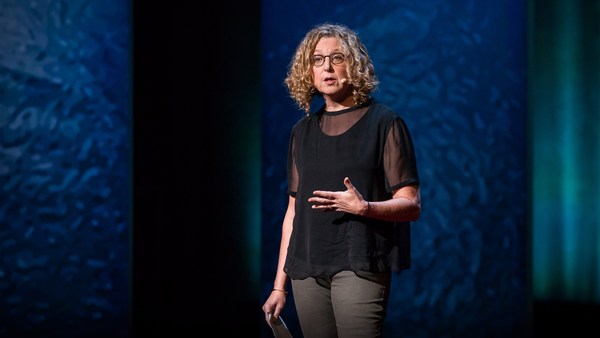In our culture we tend to see sex as something that's more important to men than it is to women. But that's not true. What is true is that women often feel more shame in talking about it. Over half of women quietly suffer from some kind of sexual dysfunction. We've been hearing more about the orgasm gap. It's kind of like the wage gap but stickier ...
(Laughter)
Straight women tend to reach climax less than 60 percent of the time they have sex. Men reach climax 90 percent of the time they have sex. To address these issues, women have been sold flawed medication, testosterone creams ... even untested genital injections.
The thing is, female sexuality can't be fixed with a pill. That's because it's not broken: it's misunderstood. Our culture has had a skewed and medically incorrect picture of female sexuality going back centuries. If over half of women have some kind of sexual problem, maybe our idea of sexuality doesn't work for women. We need a clearer understanding of how women actually work.
I'm a journalist, and I recently wrote a book about how our understanding of female sexuality is evolving. So sexuality itself was defined back when men dominated science. Male scientists tended to see the female body through their own skewed lens. They could've just asked women about their experience. Instead they probed the female body like it was a foreign landscape. Even today we debate the existence of female ejaculation and the G-spot like we're talking about aliens or UFOs. "Are they really out there?"
(Laughter)
All this goes double for LGBTQI women's sexuality, which has been hated and erased in specific ways.
Ignorance about the female body goes back centuries. It goes back to the beginning of modern medicine. Cast your mind back to the 16th century, a time of scientific revolution in Europe. Men of ideas were challenging old dogmas. They were building telescopes to gaze up at the stars. We were making progress ... sometimes. You see, the fathers of anatomy -- and I say "fathers" because, let's face it, they were all dudes -- were poking about between women's legs and trying to classify what they saw. They weren't quite sure what to do with the clitoris. It didn't appear to have anything to do with making babies. The leading anatomist at the time declared that it was probably some kind of abnormal growth --
(Laughter)
and that any woman who had one was probably a hermaphrodite. It got so bad that parents would sometimes have their daughter's clitoris cut off if it was deemed too large. That's right. Something we think of today as female genital mutilation was practiced in the West as late as the 20th century. You have to wonder: if they were that confused about women's bodies, why didn't they just ask women for a little help?
But you must be thinking, "All that was history. It's a different world now. Women have everything. They have the birth control pill, they have sexting and Tinder and vajazzling."
(Laughter)
Things must be better now. But medical ignorance of the female body continues. How many of you recognize this? It's the full structure of the clitoris. We think of the clitoris as this little pea-sized nub, but actually it extends deep into the body. Most of it lies under the skin. It contains almost as much erectile tissue as the penis. It's beautiful, isn't it? It looks a little like a swan.
(Laughter)
This sculpture is by an artist named Sophia Wallace as part of her "Cliteracy" project.
(Laughter)
She believes we need more "cliteracy," and it's true, considering that this structure was only fully 3-D mapped by researchers in 2009. That was after we finished mapping the entire human genome.
(Laughter)
This ignorance has real-life consequences. In a medical journal in 2005, Dr. Helen O'Connell, a urologist, warned her colleagues that this structure was still nowhere to be found in basic medical journals -- textbooks like "Gray's Anatomy." This could have serious consequences for surgery.
Take this in. Gentlemen: imagine if you were at risk of losing your penis because doctors weren't totally sure where it was or what it looked like. Unsurprisingly, many women aren't too clear on their own genital anatomy either. You can't really blame them. The clitoris is often missing from many sex-ed diagrams, too. Women can sense that their culture views their bodies with confusion at best, outright disdain and disgust at worst. Many women still view their own genitals as dirty or inadequate. They're increasingly comparing their vulvas with the neat and tiny ones they see in pornography. It's one reason why labiaplasty is becoming a skyrocketing business among women and teen girls.
Some people feel that all this is a trivial issue. I was writing my book when I was at a dinner party and someone said, "Isn't sexuality a first-world problem? Aren't women dealing with more important issues all over the world?" Of course they are. But I think the impulse to trivialize sex is part of our problem. We live in a culture that seems obsessed with sex. We use it to sell everything. We tell women that looking sexy is one of the most important things you can do. But what we really do is we belittle sex. We reduce it to a sad shadow of what it truly is. Sex is more than just an act.
I spoke with Dr. Lori Brotto, a psychologist who treats sexual issues in women, including survivors of trauma. She says the hundreds of women she sees all tend to repeat the same thing. They say, "I don't feel whole." They feel they've lost a connection with their partners and themselves.
So what is sex? We've traditionally defined the act of sex as a linear, goal-oriented process. It's something that starts with lust, continues to heavy petting and finishes with a happy ending. Except many women don't experience it this way. It's less linear for them and more circular. This is a new model of women's arousal and desire developed by Dr. Rosemary Basson. It says many things, including that women can begin an encounter for many different reasons that aren't desire, like curiosity. They can finish with a climax or multiple climaxes, or satisfaction without a climax at all. All options are normal.
Some people are starting to champion a richer definition of sexuality. Whether you identify as male, female or neither gender, sex is about our relationship to the senses. It's about slowing down, listening to the body, coming into the present moment. It's about our whole health and well-being. In other words, sex at its true breadth isn't profane, it's sacred.
That's one reason why women are redefining their sexuality today. They're asking: What is sex for me? So they're experimenting with practices that are less about the happy ending -- more about feeling whole. So they're trying out spiritual sex classes, masturbation workshops -- even shooting their own porn that celebrates the diversity of real bodies.
For anyone who still feels this is a trivial issue, consider this: understanding your body is crucial to the huge issue of sex education and consent. By deeply, intimately knowing what kind of touch feels right, what pressure, what speed, what context, you can better know what kind of touch feels wrong and have the confidence to say so.
This isn't ultimately about women having more or better sex. It's not about making sure women have as many orgasms as men. It's about accepting yourself and your own unique experience. It's about you being the expert on your body. It's about defining pleasure and satisfaction on your terms. And if that means you're happiest having no sex at all, that's perfect, too.
If we define sex as part of our whole health and well-being, then empowering women and girls to fully own it is a crucial next step toward equality. And I think it would be a better world not just for women but for everyone.
Thank you.
(Applause)





